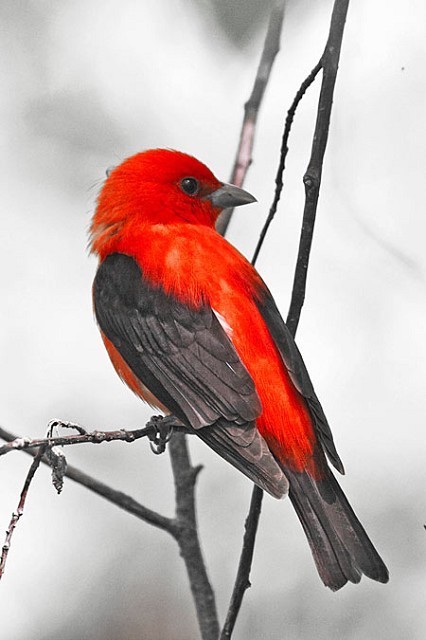On 6th May I embarked on a five-day trip to the ultimate urban landscape: New York! I hoped to make a comparison with what had been found during any similar five-day spring passage in London between 2001 and 2009 (the Canary Wharf Migrant Watch Project). The first thing that struck me were the skyscrapers: some 200 over 500 feet. A veritable wall of concrete and glass, compared to Canary Wharf's paltry eight or so. Round one to New York! Secondly the 'canyoned' green space area, running roughly north–south: a rectangular 2.6 miles × 0.5 miles wide, bounded by 8th Avenue to the west, and 5th to the east. Central Park covers a mighty 850 acres as against Canary Wharf's 6 acres. Such a comparison might at first seem absurd, but we are comparing the passerine migrant yield only. The apparent species disparity may not be as great as one might first assume. Putting the statistics to one side for the time being, and concentrating on the spectacle, I was about to embark on a technicolour adventure that would consign all other previous urban experiences to the periphery.

Stars and stripes (photo: Ken Murray)
The best way I can attempt to describe the palette that flooded the retina is to recall the first flash of sapphire...halcyon! The sheer intensity of primary colours that evolved in the neo-tropics, assaulting your optical viscera, garlanded by the dappled greens of urban parkland...pure magic! Barely three hours after touchdown, I was already stalking the rainbows of Central Park in downtown Manhattan. Low cloud, intermittent heavy showers and temperatures barely into the 20s greeted my arrival. I slowly picked my way through the resident joggers, cyclists, skaters, tourists, American, British, German, and Swedish birders to lay eyes on my first neotropic: a male Scarlet Tanager.

Scarlet Tanager, Canada (Photo: Peter Beesley)
Forget the field guide illustrations, or the latest web download, justice can only be served by the naked eye. Each morning I started out at 6am, fuelled only by a single coffee, pastry and non-stop adrenalin until dinner at 8pm. My carbohydrate 'sacrifice' resulted in a 2kg weight loss to be offset against an accrued c.40+ passerine species (compared to a Canary Wharf count, for an average 5-day, early May, spring period of c.10 migrant plus c.12 resident species).
This included nine life ticks, with a further four potential 'lifers' present, but not seen by me (Summer Tanager, Brewster's, Cerulean and Hooded Warblers). The highlights were an introduction to the 'hatch', a term used by American birders to describe a termite exodus from the nest, which prompted a feeding frenzy amongst the transients which, in turn, became a lot more confiding to the assembled birders. The irresistibility of tasty termites to passerines was awesome. I believe it to be a New World phenomenon only?
It was at the 'hatch' that I observed a bird that must stand alone as having a monopoly on almost everything that any passerine could possibly have: centre crown stripe, supercilium, eyestripe, wing-bars, braces, tail-tips, eye-ring, flank/chest-streaks and undertail-covert markings! (Did I miss anything?) What it lacked in colour, it certainly made up for in impactful contrast...Black-and-white Warbler!

Black-and-white Warbler (grab: Ken Murray)

Prothonotory Warbler
(grab: Ken Murray)
Apart from the four previously bracketed species that I did not see (being equally very scarce on spring passage), I was also able to connect with seven other 'lifer' migrant passerines: Yellow-breasted Chat, Black-billed Cuckoo, Yellow-throated/White-eyed Vireos, Worm-eating/Blue-winged and Prothonotary Warblers, all hoped for, but not realistically expected. On the human front, consideration of the highest order was exhibited at the 'hatch' by an excitable native birder who edged to the front of the assembled mass and, whilst struggling under the weight of his bazooka/digi-cam, declared to all and sundry, "Stand back...and give the Prothonotory space!" Whereupon he unleashed a battery of high-speed flash that would have illuminated the Empire State and blinded King Kong simultaneously! The incident prompted a German birder on his third spring visit to remark "where else in the civilized world could you witness such a spectacle?"
The comparison statistics for passerine species occurring in early May over a five-day period are as follows:
| Central Park | c.850 acres | c.26 breeding species | c.40+ transient species |
| Canary Wharf | c.6 acres | c.12 breeding species | c.10+ transient species |
The figures can only be approximate as there would be year-on-year differences that would make any objective analysis problematic. However, on a lighter note, using species yield to acreage an urban London 6-acre site outperformed Manhattan!

Blackburnian Warbler (grab: Ken Murray)
On the aesthetic front, I believe the competition was easily won by The Big Apple, and that the European birders present would all have wholeheartedly agreed. For anyone who has a non-birding partner, and is considering a visit to New York: they can shop-drop on 5th while you jaw-drop in Central!

Veery (grab: Ken Murray)
The Park's previously malign reputation has been transformed over the last 8 years to the point where one can feel safer there than in a comparable situation within the urban UK. 'The city that never sleeps' certainly applies to the subway, as it runs 24–7, and a $21 pre-paid subway ticket (usable on buses) should give you around 14 'anywhere' trips on the system. Thus, wherever you stay, make sure it's close to a subway station, and when alighting at 79th Street it could be your three blocks to paradise!


